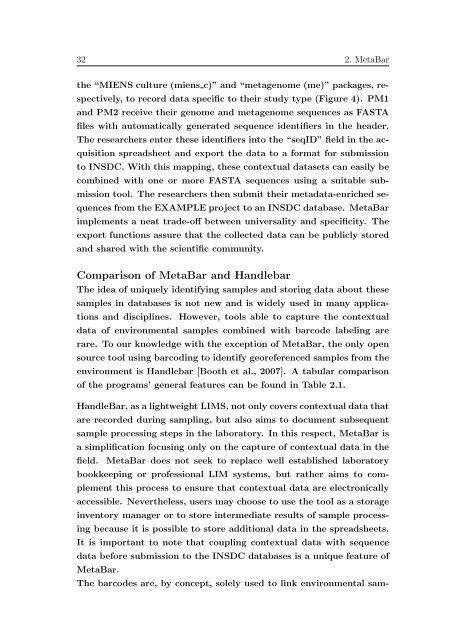Data integration in microbial genomics ... - Jacobs University
Data integration in microbial genomics ... - Jacobs University
Data integration in microbial genomics ... - Jacobs University
You also want an ePaper? Increase the reach of your titles
YUMPU automatically turns print PDFs into web optimized ePapers that Google loves.
32 2. MetaBar<br />
the “MIENS culture (miens c)” and “metagenome (me)” packages, respectively,<br />
to record data specific to their study type (Figure 4). PM1<br />
and PM2 receive their genome and metagenome sequences as FASTA<br />
files with automatically generated sequence identifiers <strong>in</strong> the header.<br />
The researchers enter these identifiers <strong>in</strong>to the “seqID” field <strong>in</strong> the acquisition<br />
spreadsheet and export the data to a format for submission<br />
to INSDC. With this mapp<strong>in</strong>g, these contextual datasets can easily be<br />
comb<strong>in</strong>ed with one or more FASTA sequences us<strong>in</strong>g a suitable submission<br />
tool. The researchers then submit their metadata-enriched sequences<br />
from the EXAMPLE project to an INSDC database. MetaBar<br />
implements a neat trade-off between universality and specificity. The<br />
export functions assure that the collected data can be publicly stored<br />
and shared with the scientific community.<br />
Comparison of MetaBar and Handlebar<br />
The idea of uniquely identify<strong>in</strong>g samples and stor<strong>in</strong>g data about these<br />
samples <strong>in</strong> databases is not new and is widely used <strong>in</strong> many applications<br />
and discipl<strong>in</strong>es. However, tools able to capture the contextual<br />
data of environmental samples comb<strong>in</strong>ed with barcode label<strong>in</strong>g are<br />
rare. To our knowledge with the exception of MetaBar, the only open<br />
source tool us<strong>in</strong>g barcod<strong>in</strong>g to identify georeferenced samples from the<br />
environment is Handlebar [Booth et al., 2007]. A tabular comparison<br />
of the programs’ general features can be found <strong>in</strong> Table 2.1.<br />
HandleBar, as a lightweight LIMS, not only covers contextual data that<br />
are recorded dur<strong>in</strong>g sampl<strong>in</strong>g, but also aims to document subsequent<br />
sample process<strong>in</strong>g steps <strong>in</strong> the laboratory. In this respect, MetaBar is<br />
a simplification focus<strong>in</strong>g only on the capture of contextual data <strong>in</strong> the<br />
field. MetaBar does not seek to replace well established laboratory<br />
bookkeep<strong>in</strong>g or professional LIM systems, but rather aims to complement<br />
this process to ensure that contextual data are electronically<br />
accessible. Nevertheless, users may choose to use the tool as a storage<br />
<strong>in</strong>ventory manager or to store <strong>in</strong>termediate results of sample process<strong>in</strong>g<br />
because it is possible to store additional data <strong>in</strong> the spreadsheets.<br />
It is important to note that coupl<strong>in</strong>g contextual data with sequence<br />
data before submission to the INSDC databases is a unique feature of<br />
MetaBar.<br />
The barcodes are, by concept, solely used to l<strong>in</strong>k environmental sam-

















